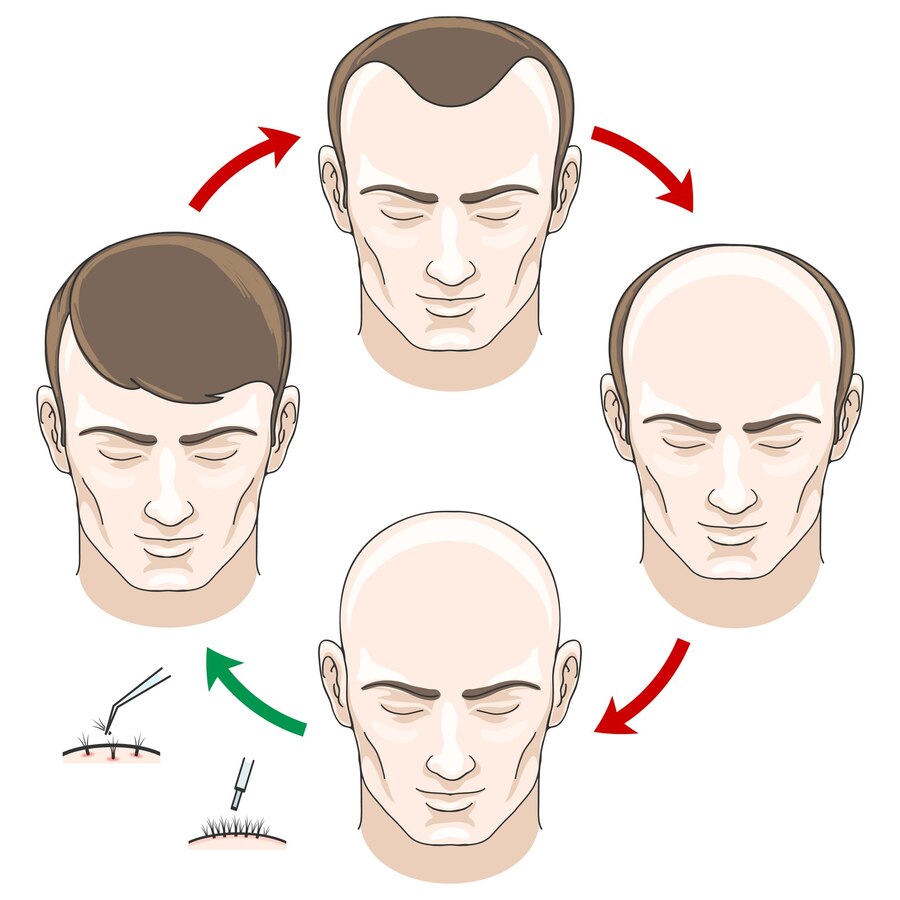Hair loss can be a distressing experience for many. Whether it’s thinning hair or receding hairlines, the journey to finding a solution often leads people to consider various options. One of the most widely recognised tools in assessing male pattern baldness is the Norwood Scale of Baldness. This scale categorises stages of hair loss, helping individuals better understand their situation.
But when should you take that leap toward a hair transplant? If you’ve noticed your reflection showing more scalp than strands, it may be time to explore what this procedure has to offer. Understanding your position on the Norwood scale can inform your decision-making process and help determine if a transplant is the right choice for you. Let’s explore how this classification system works, signs that may indicate you could benefit from a transplant, and everything else you need to know before taking action! (Information Credit: https://wanthair.co.uk/norwood-scale)
Understanding the Norwood Scale and Hair Loss Classification
The Norwood scale is an essential tool for understanding male pattern baldness. It breaks down hair loss into different stages, making it easier to assess the severity of thinning or receding hairlines.
This scale ranges from Type I, which indicates minimal hair loss, to Type VII, where significant baldness has occurred. Each stage highlights specific patterns of hair loss that can help you identify your particular situation.
By categorising these stages, the Norwood baldness scale enables individuals to anticipate what might lie ahead in their hair journey. This insight can empower individuals experiencing hair loss and guide them toward appropriate solutions, including consulting a hair loss specialist or considering advanced treatments.
Signs That You May Benefit from a Hair Transplant
If you notice your hairline receding or thinning significantly, consider a hair transplant. Early signs can often begin with the Norwood scale of baldness, moving from stage one to more advanced stages.
Additionally, if you frequently style your hair to cover bald spots, that’s another indicator. A healthy head of hair contributes significantly to self-esteem and confidence.
Are friends or family commenting on your changing appearance? This outside perspective might signal that noticeable changes are occurring.
Moreover, if you’ve tried various hair loss treatment UK options—such as topical solutions or medications—without success, it could be wise to explore surgical options instead. These scenarios highlight the potential benefits of a hair transplant, not only restoring your hair but also your self-image.
Factors to Consider Before Getting a Hair Transplant
Before undergoing a transplant, several key factors should be considered. Start by assessing your current stage on the Norwood scale hair loss chart. Understanding where you fall can help determine if you’re a suitable candidate.
Your age also plays an important role. Younger individuals may experience ongoing hair loss, which can impact long-term results. Consider how stable your hair loss is; if it’s still progressing, it may be wise to wait and reassess in a few months.
Financial considerations cannot be overlooked either. Hair transplants can be pricey and often aren’t covered by insurance. Be prepared for the investment involved.
Research potential clinics thoroughly. Look for a reputable hair loss clinic in the UK or London that features experienced surgeons and consistently positive patient reviews to ensure high-quality care and effective outcomes.
The Procedure: What to Expect During a Hair Transplant
During a hair transplant, you can expect to be in a comfortable setting. The procedure typically begins with a consultation, during which your surgeon assesses the extent of your baldness using the Norwood scale of baldness. This helps determine the number of grafts you may need.
Once you’re ready, local anesthesia is administered to ensure minimal discomfort. Depending on the method chosen—FUT or FUE—the process will vary slightly. In FUT, a strip of scalp is removed, while FUE involves harvesting individual follicles.
After extraction, the hair follicles are prepared for implantation. The surgeon makes tiny incisions in your scalp and carefully places each follicle into these slots. This meticulous work often takes several hours but results in natural-looking hair growth.
Throughout this time, you’ll have breaks and refreshments available to keep you relaxed and at ease as you undergo this transformative experience at a trusted hair loss clinic in London, such as Want Hair Ltd.
Recovery and Maintenance Tips for Optimal Results
After your transplant, following the right recovery tips is crucial for optimal results.
- Keep your scalp clean and dry. Avoid washing your hair for at least 48 hours post-surgery to allow the grafts to settle in properly.
- During the first week, avoid intense physical activities that could lead to sweating or stress on your new follicles.
- Be mindful of sun exposure—use a hat or sunscreen once you’re cleared to go outside.
- Stay hydrated and maintain a diet rich in vitamins A, C, D, E, zinc, and iron.
- Follow up with your hair loss specialist in London as recommended.
Regular check-ups ensure everything heals correctly and help address any concerns early on.
Conclusion
Balding can be a significant concern for many individuals. Understanding the Norwood scale’s hair loss stages is essential, as it provides insight into hair loss progression and helps determine if a hair transplant might be right for you.
Choosing to undergo a transplant involves careful consideration of various factors, including overall health and expectations about results. The procedure itself requires commitment, but it has proven effective in restoring not only hair but also confidence.
Exploring clinics such as Want Hair Ltd or other top-rated hair loss clinics in the UK can give you access to the best hair loss treatments and skilled surgeons. Post-surgery care is crucial for achieving optimal results; following recovery tips will ensure your new look lasts well into the future.
By identifying your position on the balding Norwood scale and working with an experienced hair loss specialist, you’ll be better equipped to make informed choices on your journey to reversing hair loss in London and regaining confidence.

